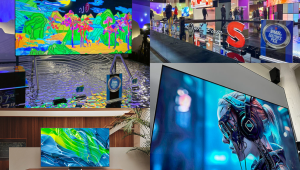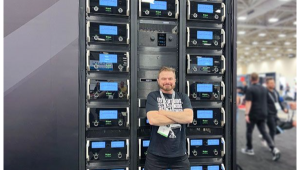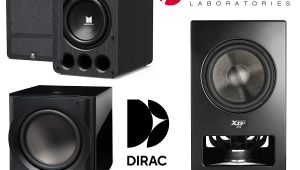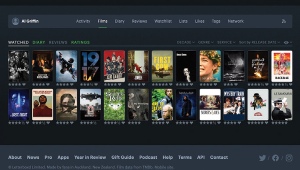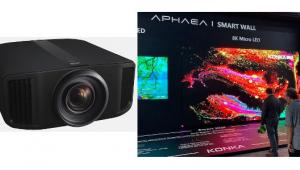Rob, subtlety is all well and good for certain films but in an action film Avengers: Age of Ultron or Ant Man I don't want subtlety. I want, no expect bombast. It's the Bombast that wows audiences in theaters which can lead to sales of new gen AVRs with Atmos and DTS-X. Discrete and subtle effects does not compel a newly minted enthusiast to go to Best Buy or visit Crutchfield's site look to spend some green. You are speaking from a theaterphiles' perspective, not the average buyer regarding overhead sound effects. And, no, aggressive surround and overhead surround use does not distract from the film.
Can Object-Based Audio Save the AVR?

We are finally starting to see the new 2015 model year AV receivers trickle in, the first generation to more or less universally include HDMI 2.0 connections along with HDCP 2.2 copyright management. The Onkyo TX-NR545 and Pioneer VSX-1130 are high value examples of this new crop; both sell for $600, a price point that has always represented a sweet spot for the enthusiast on a budget. Some of last year’s models, still floating around for sale, included HDMI 2.0 but lacked the newer HDCP scheme that would allow them to pass copyrighted 4K content delivered by stream or UHD Blu-ray going forward. Shame on some brands for touting these as though they were future-proofed when they really weren’t. This year, thankfully, everyone is getting caught up.
Also appearing on many more models this year is surround-sound decoding for either Dolby Atmos or Atmos plus DTS:X (both of the models mentioned above are Atmos-capable). For readers visiting this site for the first time (or sleeping under a rock), these are “object-based” audio systems. They use overhead speakers (or, with Atmos, the option for ear-level speakers that reflect sound off the ceiling) and allow movie and music sound mixers to take any audio element—a voice, an instrument, a sound effect—and place it anywhere in a domeshaped soundfield above the listener’s ears.
The approach differs from conventional channel-based surround sound in that, along with having overhead speakers to work with, each audio object is defined by digital metadata that describes its location in space and its volume at any given moment. The smart surround decoders used in movie theaters, and now the home environment, can use the data to map the sound to however many speakers you care to use (or that can be supported by your playback gear) for optimum performance.
We’re well into our exploration of Dolby Atmos and in its 5.1.4 configuration (with four overhead speakers), it’s clearly something to write home about.
DTS:X remains vaporware as of late August; there’s a single Blu-ray movie title that’s been released and a few AVR models that have announced decoding capabilities through an eventual firmware update. But we’re well into our exploration of Dolby Atmos (despite less than a dozen Blu-rays released to date), and in its 5.1.4 configuration (with four overhead speakers), it’s clearly something to write home about.Early on, I called Atmos the most significant upgrade in home theater since the launch of Blu-ray and the 7.1-channel lossless surround formats (Dolby TrueHD and DTS-HD Master Audio). Sound mixers are still learning how to best use the format’s capabilities (here’s a hint, mixers: It’s about subtlety, not bombast). But with the right material, the effects are incredibly natural and convincing. I’ll even say thrilling.
So far, you can’t get that with a wireless powered speaker, although Yamaha recently announced an Atmos-ready soundbar. You need an AVR or surround processor and amp combo that possesses the sophisticated processing and dynamic power to get the most from the content. Plus those extra overhead speakers. But AVR sales have been waning for a while now as the broader public moves toward all-in-one solutions that are easier to set up and use. Of course, we welcome any purchase of any ancillary sound system for any TV—but it puts pressure on a product category that is increasingly becoming the bastion of a relatively small group of enthusiast consumers and custom installers, the latter of whom are particularly well equipped to monetize the installation of a fancy high-end receiver and additional built-in ceiling speakers (along with a custom universal control system).
I just hope the overall sales volume driven by object-based audio is eventually enough to keep the AVR, the hardest working and most versatile tool in the home theater gearbox, a vital category for years to come.
- Log in or register to post comments


Well at $3000, the AVR alone costs more than most people's TVs! Nor do they have a dedicated room to set up a theater that requires such gear. Just imagine if you spent 3 grand last year and don't have ATMOS, HDMI 2.0 or HDCP 2.2!

Remember Prologic iiz, dts-neo:x, audyssey dsx, height and wide channels? People went out and upgraded receives and added more speakers only to be let down by the first generation of "immersive" surround.
Even though Atmos, DTS:X, Auro3D are somewhat different, people are going to wait to see if there will be massive movie releases before they upgrade (again). So far it does not look good for Immersive audio.

For me, 2015 is a year to let all the new technology settle down for AVRs. As you noted, copy protection circuits just became widely available. I'm going to sit this out until we get the 2016 CES announcements. In the meantime, I've upgraded my 15 year old sub to a new Power Sound Audio model, and am looking at upgrading the surrounds for a more balanced 5.1 soundfield, particularly for surround music. I am concerned that the best high quality receivers are going to become fewer and fewer, so getting a new model in the next year or so is on the list. Unfortunately, our consumer society now is placing all the emphasis on convenience and portability, and devalues quality audio, video and the build of the product itself.

You can opt to wait a year, but keep in mind that as soon as you buy, the AVR is likely to be obsolete the year later. AVRs are much like computers now in terms of longevity. Your better bet is to purchase a separate multichannel amplifier with a separate preamp/surround processor. It's the better way to proceed, so that in the future all you need do is replace the processor when technology advances make it obsolete. I am surprised that Rob Sabin, Editor of our magazine, or Mark Fleischman has not replied to our posts. Either of their feedback would be useful here to help us determine which way to go.

